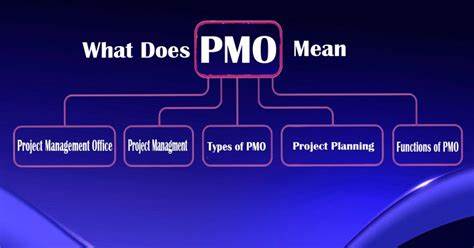PMO stands for Project Management Office. To put it simply, just like Romeo in Shakespeare’s play wonders if a rose would smell just as good if it had a different name, the same idea applies to a PMO.
No matter what we call it, its purpose and function remain the same. It’s like saying, whatever name we give to something, it doesn’t change what it actually is.
What does PMO mean?
PMO usually stands for Project Management Office, a team that helps manage projects. Sometimes, PMO can also mean Portfolio or Program Management Office.
People who work in a PMO might be called Project Management Officers.
It can be tricky because PMO is used to name different things. For example, a Project Management Officer might work in a Project Management Office, which reports to a Program Management Office, and all of this is watched over by a Portfolio Management Office. They all use the same short form, PMO!
When you look up PMO online, it gets even more mixed up. In India, PMO means the Prime Minister’s Office. And if you search for PMO on Reddit, you’ll find things that aren’t appropriate to look at while working, which is what NSFW means – Not Safe For Work. So, it’s good to be careful when searching for PMO online.
The Project or Program Management Office | PMO
Project or Program Management Offices (PMOs) are special teams set up to help with a project or program. They’re not always around forever and can be part of the project team or separate. PMOs do different things, but mainly they help with:
Support services:
- Keeping track of what needs to be done and when
- Making sure everyone and everything needed for the project is in place
- Reporting on how the project is going
- Keeping an eye on actions and money
- Planning the project and sticking to the schedule
- Checking that the project is hitting its important goals
Transparency services:
- Sharing reports with the team and people who care about the project
- Giving out clear and correct information to help make good decisions
Traceability services:
- Looking after data and documents
- Keeping a record of the project’s history
- Managing what the team knows and learns
Governance Services:
- Making sure that the right choices are made by the right people with the right info
- Helping with the project’s rules and standards
- Setting the methods for managing the project that everyone follows
- Doing checks and evaluations
In short, PMOs are there to guide and support the project, making sure it’s done right and on track.
The Portfolio Management Office | PMO
The Portfolio Management Office, also known as the Enterprise PMO, looks at the big picture of managing projects. It’s not just about handling one project or program; it’s about making sure all projects work well together. This helps the company use its staff and resources in the best way to achieve its big goals and plans.
This office keeps an eye on all the projects from above to see how they affect each other. This helps the leaders make smart choices, understanding how even little decisions can have big effects.
This PMO also takes care of the company’s guidebook on how to manage projects. This guidebook includes ideas from outside sources like the PMI and APM guides, but it also has its own rules and ways of doing things that fit the company’s needs.
The guidebook usually talks about the usual way to run projects, but now it’s also starting to include rules for more flexible, agile ways of working on projects.
Related Articles
- How to Delete or Deactivate a Snapchat Account
- How to Delete or Deactivate Your Instagram Account
- What does “time sensitive notification” mean in Snapchat?
- ATP Meaning Instagram
- What does PMO Mean in Text
The shift towards an outcomes focus
Project Management Offices (PMOs) focus on finishing projects, but Project Portfolio Management Offices care more about the results of those projects. In big-picture project management, it’s not enough to just do projects well; it’s also important to pick the right projects that match what the company wants to achieve.
These PMO teams make sure the results of the projects help the company reach its big goals. For PMOs that are a fixed part of the company and think about the long-term, it’s more important that projects add real value, not just get done.
They look at the whole company and aim to deliver value, supporting the company’s overall plan. For them, a project’s success is measured by how much it helps the company’s strategy and brings benefits, rather than just meeting deadlines, staying within budget, and being high quality.
Program Offices are in the middle of Project and Portfolio Offices, making sure that successful projects meet the goals of a bigger program.
The Agile PMO | APMO
In the Scaled Agile Framework, also known as SAFe, there’s a special team called an Agile PMO or APMO. This team works with others to manage projects in a flexible, agile way. Instead of just helping with project management, they focus on the products and the process of creating value. It’s interesting how they go beyond traditional project work! SAFe 5.0 says the APMO has three main jobs:
Coordinating Value Streams:
- Finding and using chances to improve
- Handling the connections between different parts of the project
Supporting Program Execution:
- Keeping good work patterns going
- Setting clear goals and measuring progress
- Sharing updates on how quickly and well the work is going
- Sometimes, they might even help by sponsoring projects
Fostering Operational Excellence:
- Being a leader in making changes and promoting agile methods
- Starting moves towards clear goals and budgeting that fits agile work
- Setting up and looking after the systems and ways of reporting
- Making contracts and partnerships more flexible and efficient
- Providing important measures of success and overseeing finances
- Helping communicate strategies to make sure everything runs smoothly
- Assisting HR with hiring people who are good at working in agile ways
What other types of PMOs exist?
When you’re a PMO consultant, you see many kinds of PMOs with different names and roles. They all have their own version of the PMO name and do various things, but they’re usually just special types of the PMOs we already talked about.
Here are some examples:
Project Support Office (PSO):
- This PMO is part of a project and helps with things like keeping records and organizing stuff.
Project Controls Office (PCO):
- These offices are important in big building projects. They handle all the numbers and plans to make sure the project stays on time and budget.
Delivery Management Office (DMO):
- A DMO is in charge of making sure projects are planned and done right. They keep everything moving and make sure project managers are doing their jobs.
Change Management Office (CMO):
- CMOs help a business get ready for changes. They’re more about helping people use what the project makes, while a regular PMO is more about managing the project itself.
Outsourced PMO or PMO as a Managed Service (PMaaS):
- Some companies let outside experts handle their PMO tasks. This can be good for any size company because it lets them work with a PMO that knows how to deliver big plans. But they have to be careful not to lose important things that aren’t easy to see or count.
Project Office of One (POO):
- This is a small PMO with just one person in it, usually helping out with bigger projects and programs and getting support from a main PMO in the company.
Center of Excellence
In big companies, you might find more than one PMO. Different departments might also have their own sets of projects. Centers of Excellence are special groups that show the best way to do things. They don’t worry about making reports, managing resources, or checking on project health.
Their main job is to make sure everyone in the company does things the same way and follows the project management rules. These rules get better over time because the team learns from what worked and what didn’t in past projects.
This learning helps make sure future projects do even better. Often, these Centers of Excellence are in charge of the tools everyone uses to manage projects, which helps keep everything up-to-date with the latest and best ways of running projects and training project managers.
What of the Product Management Office?
The idea of a Product Management Office (PMO) is indeed not as common as other PMO types. This might be because the selection of products is often managed by Marketing/Sales departments using methods like the Boston Matrix to choose the best product mix.
Also, product teams usually work within Development/Engineering areas, and adding another layer of governance might seem too much like red tape. Whether we’re talking about projects or products, the need for PMO services like managing knowledge, reporting, creating standards, and keeping a Body of Knowledge is clear.
It’s possible that we’ll see more organizations adopt a Product Management Office in the future to handle these important tasks.
What does the Project Management Institute (PMI) say about the PMO?
The Project Management Institute (PMI) explains what a Project Management Office (PMO) and a Program Management Office are. A PMO is a group that helps make sure projects are done in a standard way and shares tools and ways of doing things. The Program Management Office is the same, but it focuses on programs instead of projects. Right now, PMI doesn’t have a definition for a Portfolio Management Office.
PMI’s guide also talks about different kinds of PMOs and how much they control or influence projects:
Supportive PMO:
- These PMOs are like helpers, giving advice and resources to help with projects. They don’t really tell project teams what to do.
Controlling PMO:
- These PMOs help out but also make sure projects follow certain rules and steps. They check that projects are following the plan.
Directive PMO:
- These PMOs are in charge of running projects and can even be the ones to start them. They have project managers working for them and have a lot of say over how projects are done.
These ideas were shared by Luca Giraudo and Emmanuele Monaldi in 2015. They said that there’s no one perfect way to describe PMOs because they can be different based on their role in the company.
PMOs can be organized in different ways within a company, depending on their role:
Individual PMO:
- These PMOs are focused on a single project or a set of projects within a program. They set the basic rules and keep an eye on the planning and control of the project(s).
Departmental PMO:
- These PMOs are part of a specific department like IT. They help with managing projects within that department. They work like smaller versions of portfolio PMOs, planning how to use people and resources to meet the department’s needs.
Corporate PMO:
- Often called Enterprise PMOs, they are like the experts for the whole company. They work on making projects better and help plan things at a high level. They decide how to divide resources among different projects, even if those projects are in different parts of the company.












![Wells Fargo Card International and Its Fees [2024] Wells Fargo Card International](https://www.techpreview.org/wp-content/uploads/2024/07/Wells-Fargo-Card-International-238x178.png)






